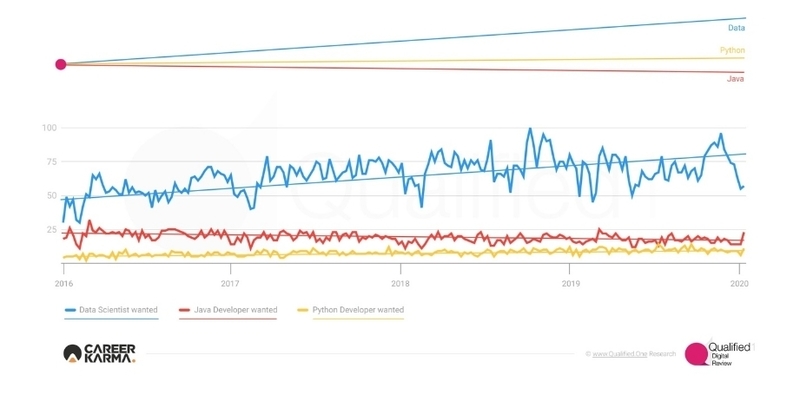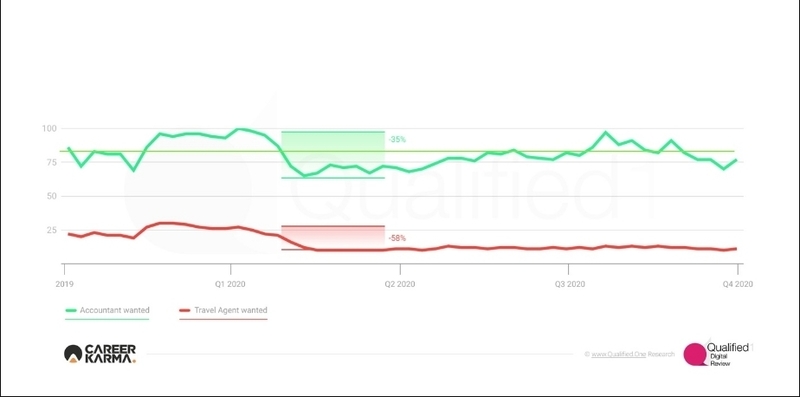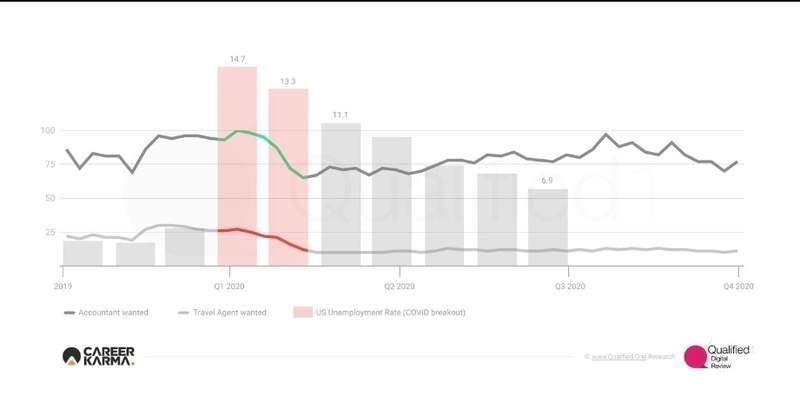Tech Job trends 2016-2020
293
0
·
2020/12/17
·
5 mins read
☕
WriterShelf™ is a unique multiple pen name blogging and forum platform. Protect relationships and your privacy. Take your writing in new directions. ** Join WriterShelf**
WriterShelf™ is an open writing platform. The views, information and opinions in this article are those of the author.
Article info
Date:
Published: 2020/12/17 - Updated: 2021/01/18
Total: 1192 words
Like
or Dislike
More to explore










17 December 2020 - Just like any previous crisis, the COVID pandemic did not bring us anything new: what happens is the acceleration of the existing trends. This can be easily seen from the changes taking place on the job market.






Long before the COVID outbreak, at the World Economic Forum in 2018 is was noted that the current advances in technology (and mostly, in information technologies) are strongly changing the landscape of job market. The employers demand considering various IT and technology skills is getting higher and higher. The same time there are also a lot of job roles that are likely to disappear in the next five to ten years.
This is mostly because of the remarkable increase in robotic, automated products that are more accurate and reliable than a typical employee dealing with the same tasks. Importantly, these solutions often are cheaper as well.
In this report we take a look at the demand associated with certain job positions, briefly discuss its dynamics over the past 4 years and compare its behavior during the first months of the pandemic in 2020.
Tech Sector: 2016-2020 growth
Let us limit ourselves with 3 specific areas of interest: Data Science, Python Development and Java Development. This may be not a perfect choice and an extended research is surely needed. Neverthe less, it allows us to get some takeaways.
Below is the chart representing how the demand in the corresponding specialists has changed since 2016 and up to 2020:
Search volume associated with different tech jobs in the USA, 2016-2020. Source: Google
One can see a significant increase in the search volume associated with the Data Science during these years. This is a long-term trend; such is the growth of the search volume related to the Python development as well.
Having said this, we should point out that Java development does not seem to be getting more popular over time. This, however, requires a more detailed analysis and can be due to outsourcing, geographical and other specific issues and is likely to be country-depending.
Jobs in Real Sector: 2016-2020
Let us now take a look at several jobs from the real sector such as Accounting. Note that we do not make any statements considering the sector as a whole: instead we focus on the specific jobs that represent the process we are talking about.
The rise of various automated solutions and the progressive digitalization make this job area very exposed to the possible forthcoming replacement with robotics.
The same (though in some other way) is true for such jobs as Travel agent or Interpreter. Basically, the information is now much more accessible and public than it used to be previously. It is also of a much greater volume. For instance, such services as booking.com and Airbnb can be a much simpler alternative to the old-fashioned travel agencies. Similar processes are happening in many other industries. Self-driving cars, car sharing, drone delivery, et cetera - all these technologies are to replace human labor with robotic, if possible.
This trend can be illustrated by the following search volume curves:
Search volume associated with different jobs in the real sector, USA, 2016-2020. Source: Google, Qualified.One
In the travel industry the human-to-human communication is still important and valuable in many cases, and this fact probably slows down the effects we mentioned above. The interpreter also cannot be replaced with an AI yet.
On the contrary, the financial systems are already performing well. Hence, we see a distinct decrease in demand considering Accounting jobs.
Dynamics comparison
It might be instructive to compare the exact growth (or decrease) rates for Tech jobs and for jobs in real sector. Let us make a simple estimation based on the linearized trend over the past four years and evaluate the relative variance:
Search volume variation associated with different jobs in the USA, 2016-2020. Source: Google, Qualified.One
Whereas the trend itself is not surprising, the speed of change is quite remarkable.
Note that such a rough analysis we may (and certainly do) lead to some mix between the job-related searches and the education-related ones. In fact, this means that one can expect a partially deferred effect. In a nutshell, there are already remarkable changes in the job market now, but it will be even greater taking into account that a lot of promising students make Tech education their long-term choice.
Effects of the 2020 Pandemic
As we mentioned in the very beginning, the crisis is always an accelerator. With no doubts, the COVID pandemic is a perfect example here.
For instance, let us dive deep into the above stats and look at the 2020:
Search volume associated with different tech jobs in the world, 2020. Source: Google, Qualified.One
One can see a large 35-40% drop in the tech jobs search volume around March-2020. The first lockdown and, to the certain extent, the common panic led to freezing of almost all HR activities in a large amount of companies.
However, it was evidently just a short-term effect. The recovery was rather quick, and we observe the demand to be around the pre-COVID levels.
The picture in the real sector is different, especially regarding the businesses that are most vulnerable to the lockdown:
Search volume associated with different real sector jobs in the world, 2020. Source: Google, Qualified.One
The accounting services were hit in the Q2 but are struggling with recovery, whereas the travel industry is totally disrupted. It is a good illustration of how sensitive these job areas are and, again, a good illustration of the catalyzation taking place during the crisis.
The unemployment
It is worth noting that the described effects are not somewhat virtual. One might think that the search volume we used to estimate dynamics does not represent the reality. Of course, a deep and detailed study is well appreciated, though it will certainly take time and require investments.
To illustrate the correlation between the metrics we used and the “real life” we use the following chart:
Search volume associated with different real sector jobs in the world and the USA unemployment. Source: U.S. Bureau of labor statistics, TradingEconomics, Google, Qualified.One
We see that the explosion on the unemployment curve is well aligned with the decrease in search volumes we outlined previously. Of course, it is unlikely to be any kind of direct effect, but a junction between the online and offline stats.
Conclusion
There is a number of jobs that are subject to gradually vanish during next years. Automation and robotics are in many cases preferable compared to human labor. This mostly applies to non-qualified, “mechanical” jobs, but not completely.
2020 has shown that these processes will probably evolve faster than previously. Tech talents are in demand - regardless of the local dropdown in March-April which was followed with a rather quick recovery.
On the contrary, such jobs as Accounting, Travel agent and some others are still experiencing an unprecedented loss of the associated search volume and are unlikely to get back till the end of the year.
Company Name: Qualified.One
E-mail: info@qualified.one
Contact Person: Michael Osipov
Adress: 4530 Harrison Street, San Francisco, CA 94103
Phone: +1 415-565-9695
Website: https://qualified.one/blog/market_research/hr2016-2020/